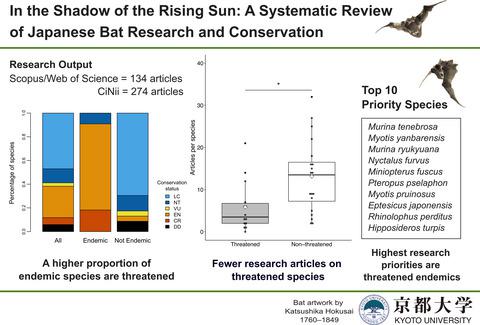当前位置:
X-MOL 学术
›
Mammal Rev.
›
论文详情
Our official English website, www.x-mol.net, welcomes your
feedback! (Note: you will need to create a separate account there.)
In the shadow of the rising sun: a systematic review of Japanese bat research and conservation
Mammal Review ( IF 4.3 ) Pub Date : 2020-12-07 , DOI: 10.1111/mam.12226 Jason H. Preble 1 , Nobuhito Ohte 1 , Christian E. Vincenot 1
中文翻译:

在朝阳的阴影下:对日本蝙蝠研究与保护的系统回顾
更新日期:2021-01-12
Mammal Review ( IF 4.3 ) Pub Date : 2020-12-07 , DOI: 10.1111/mam.12226 Jason H. Preble 1 , Nobuhito Ohte 1 , Christian E. Vincenot 1
Affiliation

|
- Although scientific evidence is critical to prioritising conservation actions, the distribution of research effort does not always align with conservation needs. The conservation of Japanese bats is of global concern, given that 35% of extant species are endemic and 91% of endemics are threatened. However, information on Japanese bats can be inaccessible to the international community, and research trends have yet to be reviewed.
- To investigate how thoroughly research has addressed conservation needs concerning Japanese bats, we related IUCN category, legal protections, and threats to the results of a systematic review of conservation‐relevant research literature from the last fifty years. We assessed patterns in research distribution in time, regions, research topics, taxa, endemicity, and category to identify gaps and future priorities. We also compared research patterns between international research repositories and the main Japanese repository.
- Categories did not change over time (except due to changes in knowledge; actual conservation status remained the same), and bat‐specific legal protections and conservation actions are limited (e.g. only one species benefits from a national recovery plan). Research has increased post‐2000, but threatened and endemic species remain less studied than non‐threatened and non‐endemic species. Both the shortage of ecological studies (≤ 1 article) and lack of any conservation study for over 50% of extant species (including most threatened species) are concerning. Ten endemics were identified as top priority species: Murina tenebrosa, Myotis yanbarensis, Murina ryukyuana, Nyctalus furvus, Miniopterus fuscus, Pteropus pselaphon, Myotis pruinosus, Eptesicus japonensis, Rhinolophus perditus, and Hipposideros turpis.
- Japanese bat conservation could be strengthened by increasing research on endemic species and by providing information on threats, ecological requirements, population trends, and suitable conservation strategies. Concrete conservation planning, improved publishing standards, capacity‐building, and a collaborative effort to improve the situation of bats domestically would set a strong example for bat conservation in Asia.
中文翻译:

在朝阳的阴影下:对日本蝙蝠研究与保护的系统回顾
- 尽管科学证据对于确定保护行动的优先顺序至关重要,但研究工作的分布并不总是与保护需求保持一致。考虑到35%的现存物种是特有的,而91%的特有物种受到威胁,日本蝙蝠的保护引起了全球关注。但是,国际社会可能无法获得有关日本蝙蝠的信息,研究趋势尚未得到审查。
- 为了调查研究如何彻底解决了日本蝙蝠的保护需求,我们将IUCN的类别,法律保护和对过去五十年来与保护相关的研究文献进行系统回顾的结果与威胁相关。我们评估了时间,地区,研究主题,分类,流行性和类别的研究分布模式,以找出差距和未来的重点。我们还比较了国际研究资料库和日本主要资料库之间的研究模式。
- 类别没有随时间变化(除非由于知识的变化;实际的保护状况保持不变),并且针对蝙蝠的法律保护和保护行动受到限制(例如,只有一种物种可以从国家恢复计划中受益)。2000年后的研究有所增加,但是受威胁物种和特有物种的研究仍然少于未威胁物种和非特有物种。既缺乏生态学研究(≤1条),也没有对超过50%的现存物种(包括大多数受威胁物种)进行任何保护研究。十个地方特有物种被确定为最优先物种:鼠李木(Murina tenebrosa),洋地鼠(Myotis yanbarensis),鼠李木(Murina ryukyuana),尼古拉斯(Nyctalus furvus),小鳞翅目(Miniopterus fuscus),翼缘蕨(Pteropus pselaphon),褐鼠眼肌(Myotis pruinosus),日本斑Ep(Eptesicus japonensis),百头犀牛(Rhinolophus perditus)和沙棘(Hipposideros turpis)。
- 日本蝙蝠的保护可以通过增加对特有物种的研究并提供有关威胁,生态需求,人口趋势和适当保护策略的信息来加强。具体的养护计划,改进的出版标准,能力建设以及共同努力改善国内蝙蝠的状况,将为亚洲蝙蝠的养护树立良好的榜样。











































 京公网安备 11010802027423号
京公网安备 11010802027423号